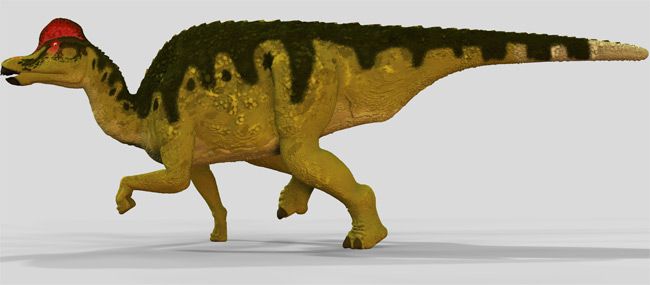Plant-Eating Dinos Grew Fast to Fend Off Tyrannosaurs

What some dinosaurs lacked in body armor, they made up for in size. The duck-billed hadrosaur grew to adulthood much faster than its predators, such as tyrannosaurs, a new study suggests.
By about age 10, the plant-eating hadrosaur called Hypacrosaurus stebingeri had likely ballooned to its mature length of 30 feet (9 meters) from nose to tail tip, the study showed. Meanwhile, the meat-eater and hadrosaur-enemy Tyrannosaurus rex would have still been a relative pipsqueak at that age, not reaching adult size until 20 to 30 years of age.
The size difference, the researchers say, would have forced the carnivorous dinos to hunt juveniles of H. stebingeri.
"The carnivorous dinosaurs are looking at the younger herbivorous dinosaurs," Lisa Noelle Cooper, a doctoral student at Kent State University in Ohio, told LiveScience. "They are actually hunting the younger ones. Once the Hypacrosaurus reaches that adult size, we think it's safer from predation. It's a size refuge." Cooper is also a researcher with the Northeastern Ohio Universities College of Medicine.
Once T. rex reached adult size, about 40 feet (12 meters) in length, the tables would of course turn, with the meat-eater coming out on top.
The results are published online today in the journal Proceedings of the Royal Society of London B: Biological Sciences.
Cooper and her colleagues compared growth rate data from H. stebingeri with three predators, all of which lived during the Late Cretaceous period from about 100 million to 65 million years ago: the tyrannosaurs Albertosaurus and its gigantic relative T. rex, as well as the small Troodon formosus, which reached just 6 feet (1.8 meters) in length and sported a relatively giant brain.
Sign up for the Live Science daily newsletter now
Get the world’s most fascinating discoveries delivered straight to your inbox.
For the hadrosaur, Cooper and her colleagues analyzed thin sections of long leg bones and counted and measured the growth rings, which each indicate a year of life. This individual dino was about 13 years old when it died.
"Our duck-billed dinosaur grew three to five times faster than any potential predators that lived alongside it," said Drew Lee, a postdoctoral fellow in Ohio University's College of Osteopathic Medicine who worked with Cooper on the finding. "By the time the duck-billed dinosaur was fully grown, the tyrannosaurs were only half grown — it was a huge size difference."
Hypacrosaurus also reached sexual maturity early, at only two or three years of age, the researchers said.
"That's another added bonus when facing predators — if you can keep reproducing, you're set," Cooper said. "It's the stuff of evolution." So if the juveniles were killed off by the meat-eating giants, H. stebingeri wouldn't go extinct, because the mothers would be churning out more offspring sooner than if they had waited until a late age to reproduce.
The research was funded by the Dinamation Society, Montana State University, Museum of the Rockies and the Charlotte and Walter Kohler Charitable Trust.
- A Brief History of Dinosaurs
- Avian Ancestors: Dinosaurs That Learned to Fly
- Image Gallery: Dinosaur Art
Jeanna Bryner is managing editor of Scientific American. Previously she was editor in chief of Live Science and, prior to that, an editor at Scholastic's Science World magazine. Bryner has an English degree from Salisbury University, a master's degree in biogeochemistry and environmental sciences from the University of Maryland and a graduate science journalism degree from New York University. She has worked as a biologist in Florida, where she monitored wetlands and did field surveys for endangered species, including the gorgeous Florida Scrub Jay. She also received an ocean sciences journalism fellowship from the Woods Hole Oceanographic Institution. She is a firm believer that science is for everyone and that just about everything can be viewed through the lens of science.












